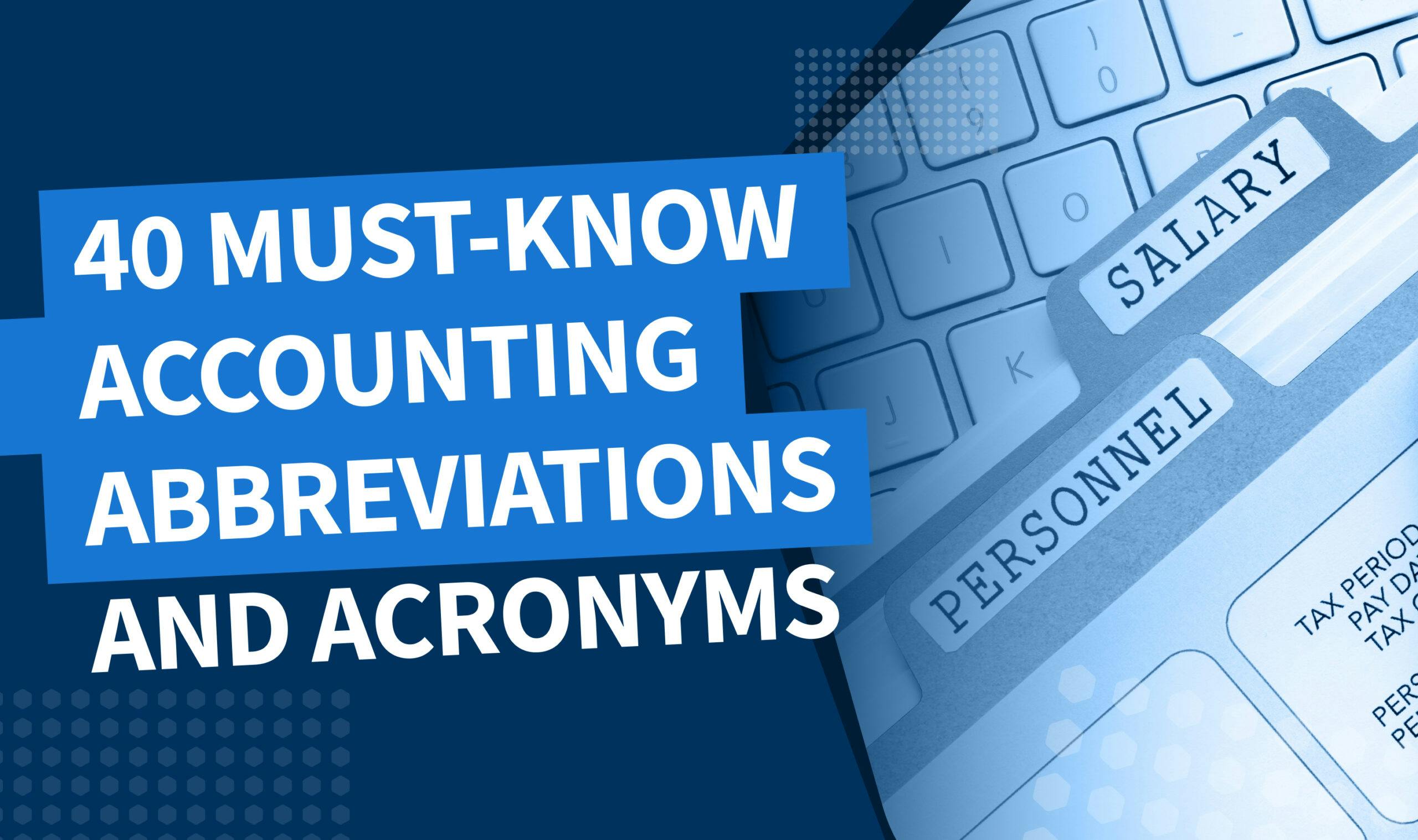
Accounting, like any other industry, has its own lingo. To the outside world, the endless use of abbreviations and acronyms can be overwhelming, but to the seasoned accounting professional, they become like a second language.
In this article, we’ll highlight 40 of the most important accounting abbreviations and acronyms to understand, so you’ll always know your AICPA from your EBITDA.
Our list of 40 essential accounting acronyms and abbreviations
There are countless accounting acronyms and abbreviations to get your head around, but the 40 examples we’ve compiled in this list are a great place to start. Enjoy!
1. AICPA — American Institute of Public Certified Accountants
Founded in 1887, AICPA is a non-profit organization that represents certified public accountants and sets accounting rules and standards in the United States.
2. AP — accounts payable
The money a business owes to its creditors, suppliers and other vendors for goods and services. Accounts payable are listed on a company’s balance sheet as a current liability.
3. APR — annual percentage rate
APR shows the cost of borrowing, expressed as a percentage. It includes both the interest charged on a loan as well as any associated fees. APR doesn’t take into account compounding.
4. AR — accounts receivable
The opposite of accounts payable, accounts receivable is the money owed to a business by other businesses for goods or services. Accounts receivable are listed on a company’s balance sheet as a current asset.
5. ASB — Auditing Standards Board
Part of AICPA, the ASB issues guidelines and standards that certified public accountants must adhere to when carrying out audits and quality control in the US.
6. BS — balance sheet
An important financial statement that provides a snapshot of a company’s financial position, including all assets, liabilities and shareholder equity. Balance sheets are usually prepared at the end of accounting periods, such as every month, quarter or fiscal year. Together with income statements and cash flow statements, balance sheets are considered one of a company’s three most important financial statements for accounting purposes.
7. CAGR — compound annual growth rate
CAGR represents the average annual growth rate of investments, balance sheets, market share, or any other metric that can rise or fall in value. Accountants may use it to better understand business and financial growth over a prolonged period.
8. CFS — cash flow statement
Another important financial statement, the CFS provides an overview of the cash that flows into and out of a company. In other words, it illustrates how well a company is managing its financial affairs, where its money comes from, and where it’s being spent.
9. CFO — Chief Financial Officer
A CFO is a high-ranking executive responsible for managing a company’s finances and directing its financial activities and strategy. In most cases, CFO is the highest-ranking financial position in a company, and they are typically responsible for managing and leading both finance and accounting departments.
10. COGS — cost of goods sold
Also known as “cost of sales”, COGS refers to the direct costs associated with producing the goods a company sells, including the cost of materials and labor. COGS doesn’t include indirect costs, such as those associated with sales and marketing, rent, equipment and other operating costs.
11. CPA — Certified Public Accountant
An official designation given to accountants who pass the rigorous CPA exam. Earning the CPA credential sets an accountant apart from other peers, showing that they have the required experience, knowledge and skill to be given this prestigious title.
12. CR — credit
The word “credit” has different meanings in finance, but in the context of accounting, it refers to a bookkeeping entry that records either a decrease in assets or an increase in liabilities.
13. DR — debit
The opposite of a credit, a debit is a bookkeeping entry that records either an increase in assets or a decrease in liabilities.
14. EBITDA — earnings before interest, taxes, depreciation and amortization
EBITDA is a measure of the income a business generates before interest, taxes, depreciation and amortization are taken into account. In this respect, it’s a simple way to measure a business’s ability to generate income from its core operations.
15. EIN — Employer Identification Number
A unique number assigned to a business to identify them in tax matters relating to the IRS.
16. FASB — Financial Accounting Standards Board
The FASB is the standard-setting body that establishes and oversees the Generally Accepted Accounting Principles (GAAP) in the United States.
17. FIFO — first in, first out
FIFO is a method used in asset and inventory management whereby the assets acquired first are disposed of first. In other words, when accountants apply the FIFO method, assets are sold in the same order they were bought.
18. FS — financial statement
A general term for the statements a company keeps to record financial performance and activities. There are many kinds of financial statements, but the three most important ones are the income statement, balance sheet and cash flow statement.
19. GAAP — Generally Accepted Accounting Principles
GAAP is a set of accounting rules and standards developed and maintained by the Financial Accounting Standards Board (FASB). GAAP is widely used in the US. Most other countries adhere to the International Financial Reporting Standards (IFRS).
20. GL — general ledger
A general ledger is a company’s primary financial record-keeping system, encompassing all the financial transactions a company has made, aggregated from various sub-ledgers, including accounts payable, accounts receivable, and so on.
21. IASB — International Accounting Standards Board
The IASB is the standard-setting body responsible for developing and overseeing the International Financial Reporting Standards (IFRS).
22. IFRS — International Financial Reporting Standards
The IFRS is a set of global accounting standards developed and overseen by the International Accounting Standards Board (IASB). Unlike GAAP, IFRS takes a principles-based approach rather than focusing on detailed rules.
23. IRA — individual retirement account
A form of pension or long-term savings account in the US that holds several tax advantages. IRAs are designed as a way for self-employed individuals, who don’t have access to a 401k account, to save for their retirement.
24. IRS — Internal Revenue Service
The IRS is a United States government agency and division of the Treasury Department that deals with federal tax matters. Essentially, the IRS is responsible for administering tax laws and collecting federal taxes from taxpayers.
25. IS — income statement
As one of the three key financial statements used by companies to summarize their financial performance, the income statement provides a snapshot of a company’s revenues, expenses, profits and losses over a given accounting period.
26. LIFO — last in, first out
An alternative method to FIFO (first in, first out) for business inventory accounting, LIFO assumes that the most recently purchased items are the first ones to be sold.
27. LLC — limited liability company
A popular legal structure for a company that protects the company’s owners from its debts and liabilities. If an LLC is unable to pay its debts, for example, the owners will not be personally pursued to repay those debts.
28. NI — net income
Net income, also known as net profit or net earning, is an important financial metric that represents a company’s total profit. It’s calculated by deducting all expenses from a company’s total revenue. NI can also be used to describe an individual’s take-home income after all taxes and other deductions have been accounted for.
29. P&L — profit and loss
A P&L statement is another term used to describe an income statement.
30. PP&E — property, plant and equipment
The long-term, tangible (i.e. physical) assets owned by a business that are essential to its operations. Examples include machinery, equipment, real estate and other property. Because of their physical nature, PP&E items are not easy to liquidate. Some tend to depreciate over time (e.g. machinery and equipment), while others tend to appreciate in value (e.g. real estate).
31. QOQ — quarter over quarter
QOQ measures the change in financial performance between one quarter and the next. It could be applied to revenue or profit, for example.
32. ROA — return on assets
ROA is an important financial metric that measures a company’s ability to generate profit from the assets on its balance sheet. It’s a good indication of how efficiently a company is run, and how well it uses its economic resources.
33. ROE — return on equity
Another key financial metric, ROE measures how profitable a company is in relation to its shareholder’s equity. It’s calculated by dividing net income by shareholder equity and is an indicator of how effective a company is at turning equity financing into profits.
34. ROI — return on Investment
ROI measures the financial return on an investment relative to its cost. It’s an effective way to understand the success or otherwise of an investment, or to compare multiple investments side by side.
35. OP — standard operating procedure
SOPs are clearly defined and documented instructions for specific tasks and processes, ensuring a level of consistency, quality and compliance. While the term isn’t specific to accounting, you’ll certainly find plenty of SOPs when it comes to financial and accounting procedures.
36. SOX — Sarbanes-Oxley Act
The Sarbanes-Oxley Act is a US federal law that sets out rules for financial reporting and record-keeping. SOX was introduced in 2002 in reaction to several high-profile accounting scandals, including Enron.
37. TB — trial balance
A trial balance is a report that compiles all the balances of all the accounts in a company’s general ledger at any point in time. Creating a trial balance is an important step towards closing the books at the end of an accounting period or preparing for an audit.
38. TIN — taxpayer identification number
A unique number assigned to an individual to identify them in tax matters relating to the IRS.
39. YE — year end
YE refers to the end of a business’s accounting year, when they typically need to undertake the financial year-end reporting process.
40. YOY — year over year
Like quarter over quarter (QOQ) but instead measuring growth from one year to the next.
Conclusion
Accounting can be a highly complex profession — not only in terms of the processes involved but also the unique terminology. If you’re just starting out or taking your first bookkeeping course, the endless acronyms are enough to make your head spin.
To help you get up to speed, we’ve covered 40 of the most important accounting abbreviations and acronyms that you’ll come across. Master these, and you’ll be well on your way to becoming fluent in the language of accounting.

Thank you! The eBook has been sent to your email. Enjoy your copy.
There was an error processing your request. Please try again later.
Looking to boost your firm's profitability and efficiency?
Download our eBook to get the answers



